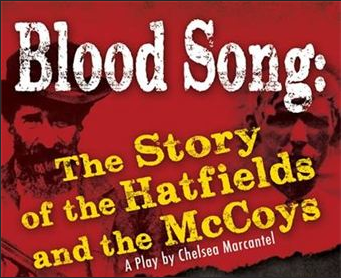Writing History: Hatfield-McCoy Feud Takes Local Stage Next Week
by Mary Meadows • July 19, 2013

Medical Leader | Photo courtesy of CHELSEA MARCANTEL
PLAYWRIGHT: Virginia native Chelsea Marcantel didn’t know much about the Hatfield & McCoy Feud before she was selected to write a play that will be performed in Pikeville this month. In preparation, she studied books, conducted online research and consulted with local historians to create the play. A director and playwright, Marcantel has earned numerous honors for her work over the years, including awards from the Women’s Theatre Alliance of Chicago and the Chicago Union League Civic and Arts Foundation. She is a member of the Dramatists Guild of America and The Playwrights’ Center.
MCCARR — Playwright Chelsea Marcantel has written historical plays before, but this year marks the first time that the history she’s writing about is still entwined in the community.
She started working on “Blood Song: The story of the Hatfields & McCoys” for the Hatfield & McCoy Arts Council in February. It’s been a “labor of love,” she said, because she respects the history of the feud and relatives of the feuding families who still live in the area.
“Stories like this are always interesting,” she said. “It’s so fascinating to me when I visit an area and I drive
around and see that names on businesses and on signs of people running for election are the same names of the people in the play I’m writing about. I see that these are the people; they’re still here. I’ve never worked on a project like that. I’ve worked on historically-inspired projects, but I’ve never worked on something where getting the history and the details right are so paramount.”
She’s excited to see the play on stage and plans to attend at least one performance.
“I really enjoy telling the stories of a particular region,” she said. “It’s a whole different type of writing when people you’re doing the play for people who know the characters and know how it’s going to end.”
Marcantel, an Abington, Virginia, resident who teaches Introductory Playwrighting at Virginia Intermont College, didn’t know a lot about the infamous feud before the Hatfield & McCoy Heritage Council selected her as playwright.
“I hadn’t even seen the History Channels’ miniseries,” she said. “I read a lot of books and did a lot of online research and I got things every day from historians who were working with me on this play. It was a flood of information. One of the challenges of writing this play was how we could condense it into something we could put on stage. The History Channel had six hours. We had to do something so the play wouldn’t run until midnight.”
She structured the play so that every scene opens with a narrator who provides some historical information about events that have happened since the last scene and sets the tone for the upcoming action. She alternates the narration between men, women, Hatfields and McCoys and attempts to highlight the perspectives of women and younger people involved in the feud to give the audience something they may not know about the feud.
“It was really hard to do. It was pretty difficult,” she said, when asked how she decided what parts of the feud to include in the play. “That’s why I’m glad I had historians on my side to help. I absolutely couldn’t have done it without the arts council and everyone at the Artists Collaborative Theater who helped me. It would have taken me years to write this story on my own.”
She finished the first draft in six weeks.

Blood Song: The Story of the Hatfields & McCoys
Performance schedule:
July 26-27 at 7:30 p.m.
July 28 at 3 p.m.
August 2-3 at 7:30 p.m.
August 4 at 3 p.m.
August 23-24 at 7:30 p.m.
August 25 at 3 p.m.
August 30-31 at 7:30 p.m.
September 1 at 3 p.m.
September 2 at 3 p.m.
All shows will be held at the Hatfield & McCoy Amphitheatre, McCarr
For more information, visit http://hatfieldmccoyarts.com.
Hatfield & McCoy Heritage Council members Stephanie Richards, Betty Howard, Chris Coleman, Andrea Coleman and Randall Osborne helped Mercantel filter through mounds of works that have already been published about the feud.
“One of the problems with writing a historical play is that you can read all the historical information about it that there is to read, but it doesn’t cover what’s in people’s hearts,” she said. “If I had a question about why such and such joined the Union or Confederate army, I could call these historians and they could shed some light on that for me. It’s that human side of it that you don’t get from the other information that’s out there.”
“I hope the community feels ownership of this play. I wanted it to be accurate,” she said. “Obviously, the things that people are saying are mostly fictitious, but I didn’t want there to be any incongruent errors that would take people out of the story.”
She said one of the hardest things she had to do was title the play. It’s usually the last thing she writes, and the heritage council needed the name of the play early for marketing purposes.
“After I got the ending of the first draft of the play completed, I started thinking about the reason people would be so protective of their family and what would keep them all together,” she said, “And the idea of hearing this Bloodsong, that blood of kinship, …is something that is outside your body that you can hear and you can feel from miles away. The idea of a blood song being an external force that draws people together and keeps them together, giving them something to fight for even if common sense goes against it, is the meaning behind the play’s title.”
She believes the story of the feud is still relevant today.
“It’s really interesting,” she said. “Even though it happened so long ago, I feel it’s a very modern story. This idea of people who settle into one way of thinking; that belief that ‘I’m right and you’re wrong;’ that’s a trap that we can still fall into. It’s a human story.”
She encourages people to watch the play.
“I hope that people will come and see it because it’s born and grown in the community,” she said. “I hope this play will make them feel proud of this event…That’s my biggest hope for the audience.”
“Blood Song: The story of the Hatfields & McCoys” will debut at the Hatfield & McCoy Amphitheatre in McCarr at 7:30 p.m. on July 26.
Live performances will continue at 7:30 p.m. on Fridays and Saturdays and at 3 p.m. on Sundays through September 1. The final performance will be held at 3 p.m. on Labor Day.
Tickets are $10.
For more information about the play, visit http://hatfieldmccoyarts.com. For more information about Marcantel, visit http://chelseamarcantel.com.
For more information and tickets, click here.






